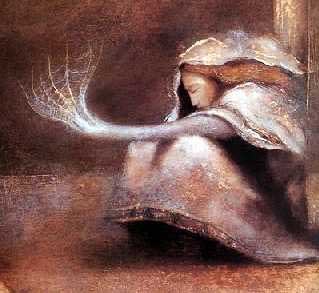
Arachne Greek Goddess, Superior weaver to
The Moirae, the Fates are the three crones who control destiny, whose fate is unraveled it is the art of spinning on the distaff the thread of life. Penelope the faithful wife of Odysseus was a weaver, weaving her design for a shroud by day, but unravelling it again at night, to keep her suitors from claiming her during the long years while Odysseus was away. Penelope has a high lineage that melds human and divine, and is she perhaps secretly Odysseus' own weaving goddess-nymph, like the two weaving enchantresses in the Odyssey, Circe and Calypso.
Helen of Troy is at her loom in the Iliad. Homer dwells upon the supernatural quality of the weaving in the robes of goddesses, and every writer reaching for a heroic style after him imitated an analogous passage. There is a terrible tale about Philomela who was raped and her tongue cut out so that she could not tell about her violation. Her loom becomes her voice, and the story is told in the design, so that her sister Procne may understand and the women may take their revenge.
Egyptian Goddess of Weaving and War
Baltic myth, Saule is the life-affirming sun goddess, whose numinous presence is signed by a wheel or a rosette. She spins the sunbeams. The Baltic connection between the sun and spinning is as old as spindles of the sun-stone, amber, that have been uncovered in burial mounds. Baltic legends as told have absorbed many images from Christianity and Greek myth that are not easy to disentangle.
-
China, In the Tang Dynasty, the weaving goddess floated down on a shaft of moonlight with her two attendants, showed to the upright court official Guo Han in his garden that a goddess's robe is seamless for it is woven without the use of needle and thread, entirely on the loom. The phrase "a goddess's robe is seamless" passed into an idiom to express perfect workmanship.
-
The Finnish epic, the Kalevala, has many references to spinning and weaving goddesses.
-
Germany In the Germanic mythology the spinner is Holda. Her patronage extends outward to control of the weather, and source of women's fertility, and the protector of unborn children, without ever losing her role as the patron of spinners, rewarding the industrious and punishing the idle. A Grimm tale, "The Spindle, the Shuttle and the Needle," embeds social conditioning in fairy tale with mythic resonances, rewards the industrious spinner with the fulfillment of her mantra. It recounts how the magic spindle, flying out of the girl's hand, flew away, unravelling behind it a thread, which the Prince followed, as Theseus followed the thread of Ariadne, to find what he was seeking: a bride "who is the poorest, and at the same time the richest." He arrives to find her simple village cottage magnificently caparisoned by the magically-aided products of spindle, shuttle and needle.
-
Hindu Maya is the Virgin aspect of the triple Hindu Goddess, symbolized by a Spider, spinner of magic, fate and earthly appearances. The spider's web was likened to the Wheel of Fate and the spider to the Goddess as a Spinner, sitting at the hub of Her Wheel. Mother of the Enlightened One, Buddha.
-
Romans continue to regard the processes of spinning and weaving with superstitious awe. In many parts of the Roman empire, laws banned women from holding a spindle in public: should anyone lay eyes on such a woman, it could mean exceptionally bad luck perhaps even the failure of the harvest.